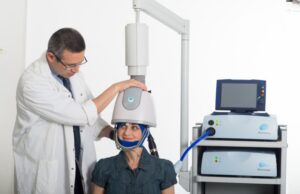How Is Epidural Anesthesia Administered For Childbirth?
5 min read
Male anaesthesiologist wih monitor in operation room
Lumbar epidural anaesthesia (also called epidural block or nerve root anaesthesia) has been around for many years. It is one of the most effective and standard pain relief methods during childbirth. Its use is widespread both in vaginal delivery and in caesarean sections.
However, the use of this anaesthesia carries some risks, so patients must receive detailed and complete information to be able to decide for themselves. Before placing the epidural, informed consent must be signed.
What is epidural anaesthesia?
Epidural anaesthesia is a local anaesthetic that numbs the lower part of the body (from the waist down) and blocks the pain of contractions without losing muscle tone. It consists of securing the nerve roots responsible for transmitting pain during the stages of labour (dilation and expulsion). This anaesthesia is safe for the mother and the newborn and is effective against pain, anguish and stress.
It allows the mother to be mobile and aware and can be used for vaginal and cesarean delivery. In addition, it improves maternal oxygenation by decreasing the mother’s hyperventilation, which often occurs during contractions.
The use of epidural anaesthesia is indicated in the following cases:
- Maternal indications: abnormal delivery due to maternal or fetal causes (dystocic delivery), induced labour, vaginal delivery after caesarean section, preeclampsia(arterial hypertension and presence of proteins in the urine), maternal pain, respiratory, renal, neurological and neuromuscular diseases.
- Fetal indications: prematurity, retarded intrauterine growth, breech presentation, twin gestation, trial delivery.
When can it be administered?
Epidural anaesthesia must be performed by experienced personnel, usually by an anaesthetist or a nurse anaesthetist (a nurse with special training in pain relief). The moment to put the epidural is generally decided by the gynaecologist or the midwife, depending on the contractions and dilation of the patient. In general, it is administered when you have intense and long-lasting contractions and there is dilation of the cervix above 2-3 centimetres, as follows:
An anaesthetic is applied through serum in the dilation room to prevent the patient from moving due to contractions during the epidural application.
The patient is placed sitting or lying in the fetal position on the left side, and the skin area of the back is carefully disinfected with an antiseptic solution, which corresponds to the epidural space (space that surrounds the spinal cord) where the puncture and infiltrates a small amount of local anaesthetic so that it is not painful.
A special epidural needle is inserted into the lower back, approximately at the level of the lumbar vertebrae L2-L3, to introduce the epidural catheter (flexible and very fine). The process can bother a bit, although it does not cause pain; the puncture is carried out between two contractions. The needle is withdrawn, and the catheter is left in, with anaesthesia injected through it to numb the nerves in the chest and lower half of the body (the epidural catheter will be left in place throughout labour and delivery). Inserting the catheter may cause cramping in one or both legs or a tingling sensation.
The entire epidural anaesthesia procedure usually lasts between 20 and 30 minutes. Subsequently, the woman will notice a progressive decrease in the pain of the contractions, but the pain will not completely disappear until after 15-30 minutes. The patient will see the contractions and how the gut hardens, but they will not hurt. As labour progresses, if the pain returns, more anaesthetic may be given through the catheter.
The amount of anaesthesia is regulated according to the needs of each patient. The anaesthetist can administer medication as needed through the catheter in your back without having to re-inject it.
Depending on the position maintained after the catheter placement, the anaesthesia can be located in different body parts, with one side receiving more than the other. It is also possible that the drug does not reach some areas.
What will the mother notice?
Once the anaesthesia has taken effect, you will feel numbness in your abdomen and legs, which can lead to loss of sensation. You will not lose mobility, but you will lose your urination reflex. The patient must be catheterised with a bladder catheter to evacuate the bladder before each scan.
You will notice a significant relief from the pain of the contractions, which will feel like a sensation of pressure, being much more distant and bearable. Feeling the contractions is beneficial because it helps to start pushing.
The duration of the effects of anaesthesia is prolonged throughout the dilation regardless of the number of hours since an anaesthetic is introduced through the catheter that has been left.
After childbirth, the sensitivity and mobility of the legs are recovered in a few hours. The catheter can be kept for a few more hours to have the possibility of administering anaesthesia to the patient and relieve the pain of the injuries or stitches.
In those situations in which the delivery ends in caesarean section, more doses of anaesthetic are administered through the catheter without the need to puncture the woman again.
After epidural anaesthesia, the pregnant woman may start with tremors. This is a normal reaction due to the fluids being put into the IV drip, which are more relaxed than the woman’s blood. The patient can be covered with a blanket.
It is the most effective analgesic technique, achieving entirely satisfactory pain relief. It is completely effective in about 96% of cases, but there is a small percentage of women in whom only an incomplete blockage is achieved, or even in some cases, it has no effect at all.
scheduled cesarean
In cases of scheduled cesarean section, three types of anaesthesia can be performed: general, epidural or spinal. General anaesthesia is used when the intervention is urgent or epidural anaesthesia is contraindicated, putting the woman completely asleep.
The epidural anaesthesia technique is the same as for childbirth, only this time, the dose of anaesthetic is increased, and the patient notices that her legs are completely numb and immobile. Still, she perceives that they are touching her and pressing her abdomen.
spinal anaesthesia
It is similar to the epidural but inserts a finer needle that reaches the spinal space. A minimal dose of local anaesthetic is applied, achieving a total motor block in which nothing can be moved or felt from the navel. Both epidural and spinal anaesthesia allows the patient to be awake and see the baby. Afterwards, she will remain pain-free for a few hours.







